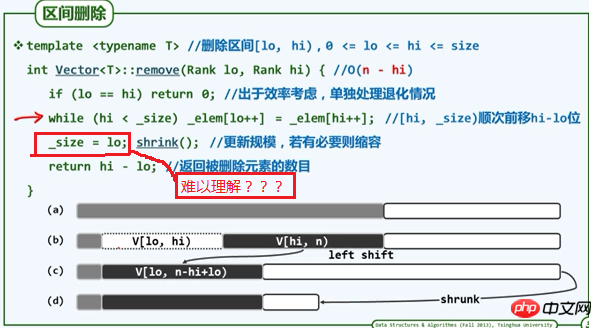
正在自学数据结构,遇到一个问题(如图)始终难以理解:_size=lo为更新规模,或者说丢弃尾部的操作,为什么不是hi=_size,因为元素移位后,有效的数据序列应该是n-hi+lo位置之前的元素构成的,也就是vi[hi]之后的元素都应该丢弃,所以hi=_size不是很合理吗。
希望大神可以帮忙解决,谢谢!
伊谢尔伦2017-04-17 13:36:29
Because the elements between [hi,_size] are used to cover the elements in the [lo, _size+lo-hi] interval.
hi increases to _size, and the corresponding lo will increase to _size+lo- hi,
that is, _size+lo-hi is the position of the last element, that is, the new _size value
The code uses lo to mark the position of the last element, so the final size is _size=lo.
怪我咯2017-04-17 13:36:29
In this function, lo and hi are both value-passed parameters, that is, these two values are destroyed after the function is completed.
is a member of vector. It uses _size to determine the number of elements saved. _sizeSo what needs to be modified here is
, not _size. hi
黄舟2017-04-17 13:36:29
hi=_sizeUnreasonable
hi is the right endpoint of the interval to be deleted at the beginning, and after while ends, it represents the right endpoint of the remaining elements; before _size is updated, it represents the right endpoint of the element before it is deleted, whileAfter the end, the unupdated _size is meaningless. What the hell is assigning hi to _size
lo and hi are local variables (parameters), and their scope is within the function. They are destroyed after the function is executed. It is meaningless to update hi.
represents the size of the vector _size, which is the value returned by calling v.size(), so _size